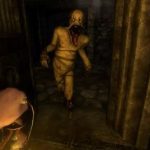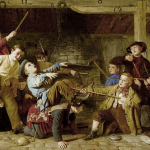 Weird Stuff
Weird Stuff  Weird Stuff
Weird Stuff  Our World
Our World 10 Ways Your Christmas Tree Is More Lit Than You Think
 Movies and TV
Movies and TV The 10 Coolest Stars to Set Sail on The Love Boat
 History
History 10 Things You Didn’t Know About the American National Anthem
 Technology
Technology Top 10 Everyday Tech Buzzwords That Hide a Darker Past
 Humans
Humans 10 Everyday Human Behaviors That Are Actually Survival Instincts
 Animals
Animals 10 Animals That Humiliated and Harmed Historical Leaders
 History
History 10 Most Influential Protests in Modern History
 Creepy
Creepy 10 More Representations of Death from Myth, Legend, and Folktale
 Technology
Technology 10 Scientific Breakthroughs of 2025 That’ll Change Everything
 Weird Stuff
Weird Stuff Ten Bizarre Facts About The Doge Meme
 Our World
Our World 10 Ways Your Christmas Tree Is More Lit Than You Think
 Movies and TV
Movies and TV The 10 Coolest Stars to Set Sail on The Love Boat
Who's Behind Listverse?

Jamie Frater
Head Editor
Jamie founded Listverse due to an insatiable desire to share fascinating, obscure, and bizarre facts. He has been a guest speaker on numerous national radio and television stations and is a five time published author.
More About Us History
History 10 Things You Didn’t Know About the American National Anthem
 Technology
Technology Top 10 Everyday Tech Buzzwords That Hide a Darker Past
 Humans
Humans 10 Everyday Human Behaviors That Are Actually Survival Instincts
 Animals
Animals 10 Animals That Humiliated and Harmed Historical Leaders
 History
History 10 Most Influential Protests in Modern History
 Creepy
Creepy 10 More Representations of Death from Myth, Legend, and Folktale
 Technology
Technology 10 Scientific Breakthroughs of 2025 That’ll Change Everything
Ten Horror Games That Were Banned for Being Even Darker
We’ve already covered the ten horror games banned for being too dark, but apparently, there’s no shortage of developers willing to take things even further. Whether it’s graphic violence, real-life tragedies turned into “entertainment,” or just concepts that should’ve been rejected immediately, these games didn’t just cross the line—they removed it.
Due to commenters’ demands, this is the darker part two of “Ten Games That Were Banned for Being Too Dark.” Let’s start this list by pointing out something important. The age of consent in Japan is 12 years old. Due to this difference, specifically within the U.S., where I’m from, this list is centered around this fact. This list is, as promised, darker than its first part, so I will leave this as a trigger warning.
Related: Top 10 Insane Video Game Premises
10 Lolita Syndrome
Released in 1983 by Enix (yes, the same Enix behind Dragon Quest), Lolita Syndrome is one of the darkest chapters in gaming history. Developed for the NEC PC-8801, this game takes players inside “Maison Lolita,” a house filled with underaged cartoon girls trapped and repeating deadly games every day. Each room in the house presents a different minigame, with the player tasked with saving the girls from violent deaths—only to be “rewarded” with erotic drawings if successful.
The minigames are pretty simplistic. One involves picking the right key out of ten to stop a buzz saw from slicing a girl in half. Another tasks the player with avoiding lethal darts while using the rest to hit a girl strapped to a dartboard. In another, you face a sleeping girl who must be awoken using specific text commands while a game of rock-paper-scissors escalates into a life-or-death situation. The chaos is coupled with plenty of gory scenes, creating sadistic puzzles for the player to go through.
However, Lolita Syndrome is mostly infamous for heavily leaning into the 1980s “Lolicon Boom,” a cultural trend in Japan. It is a mix of gore, exploitation, and eroticism, which earned itself a cult following and intense backlash. Many critics, including Cracked magazine, have slammed it for “contrived and sadistic” content involving “sexually suggestive toddlers.”[1]
9 Harvester
Released in 1996, Harvester had one goal in mind—it had to be the most violent game ever made. Set in the town of Harvest, the game features everything from satanic rituals to cannibal neighbors. You play as Steve, an amnesiac trying to join a shadowy group called “The Order of the Harvest Moon,” because apparently running as far away as possible didn’t come to mind.
The gameplay is a point-and-click game in an evil Lodge with a mixture of real-life videos and pixelated PS2-like graphics, plenty of puzzles, and lots of jumpscares. Whether you’re dealing with a serial-killing sheriff or a refrigerator full of raw meat eaters, every corner of Harvest is soaked in blood—or something worse.
Ah, and don’t forget about filling out the application to join a cult. It’s only after you join the cult that things get actually violent and gory. Don’t worry; it’s weird the whole time, though. Let me say that there is PLENTY of blood and gore in this game, and considering that some of the gore depicted is actual real-life videos and actors, it’s definitely more mature than most video games.
Not surprisingly, Harvester was banned in Germany for its explicit violence and then became the target of outrage everywhere else.
Even more disturbing is Kurt Stephen Kistler, the actor who portrayed protagonist Steve. Years after the game’s release, Kistler was arrested on charges related to child pornography, adding a new layer of unease when playing the game.[2]
8 Zog’s Nightmare
Zog’s Nightmare is a game that portrays raw hatred. The neo-Nazi propaganda game was released in 2006 by Matthew Ramsey (alias Jim Ramm), a former member of the National Socialist Movement. The title refers to “ZOG,” short for “Zionist-occupied government,” the center of anti-Semitic conspiracy theories. As a Jewish person myself, I couldn’t help but feel a large pit in my stomach when researching about the game.
The game lets players battle against Jewish soldiers adorned with yellow stars while a racist parody of the Beastie Boys’ “Fight for Your Right” blares in the background, rewriting the lyrics to “You gotta fight for a white country.” It’s as uncreative as it is morally reprehensible. Ramsey went on to demonstrate how he used a first-person shooter creation tool to emphasize how easy it was to make to encourage “other racialists” to create their own propaganda games.
Unsurprisingly, Zog’s Nightmare has been banned from any mainstream platform. However, it still circulates in neo-Nazi forums and hate groups.[3]
7 RapeLay
Few games in history have managed to embody depravity as well as RapeLay. This 2006 erotica title was developed by Illusion. Set in modern Japan, the game follows Masaya Kimura, a vengeful predator who stalks, gropes, and rapes a mother and her two daughters, aged 12 and 17. The mechanics of the game reward players for “breaking” victims and tracking pregnancies with an “internal ejaculation counter.”
The game quickly sparked international outrage when its existence became widely known in 2009. Critics pointed out how it normalized gender-based violence, reinforced misogynistic attitudes, and exploited loopholes in Japanese laws that don’t criminalize depictions of fictional minors in pornographic material. Human rights organizations, like Equality Now, campaigned against the game, citing it as an example of how media can perpetuate harmful stereotypes about women and girls.
Globally, RapeLay was banned in multiple countries, including Argentina and Australia. In Japan, after public outcry and mounting international pressure, Illusion ceased its distribution. It erased all references to the game from its site. Yet this didn’t stop pirated versions from spreading online, perpetuating its sordid legacy.
Some people, however, argued that banning such games could lead to a slippery slope of censorship in art and media. But I’m pretty sure that there should be a line somewhere, and this was, maybe, way past that point.[4]
6 Ethnic Cleansing
Of course, Zog’s Nightmare is just one game of many. Take Ethnic Cleansing. Released by the neo-Nazi group National Alliance on Martin Luther King Jr. Day in 2002—because, of course, it was—this first-person shooter invites players to role-play as a Ku Klux Klan member or a neo-Nazi skinhead. Your goal? Shoot Black, Latino, and Jewish enemies.
The game’s level progression is like a racist Mad Lib: You start in a run-down ghetto mowing down minorities, each depicting the most stereotypical characteristics possible, then descend into a subway where Jews scream “Oy Vey!” as you shoot them. The final boss? Israeli Prime Minister Ariel Sharon wielding a rocket launcher because the backlash wasn’t going to be explosive enough, I suppose.
Marketed as “the most politically incorrect game ever made,” Ethnic Cleansing was sold for the extremely unsubtle price of $14.88—neo-Nazi code for their slogan. Despite its terrible graphics and clunky mechanics, the game still managed to horrify everyone worldwide. Even some white supremacists reportedly found it too ridiculous to take seriously, which is really saying something.
It was then banned from major platforms and condemned globally.[5]
5 Splatter School
Take the gory violence of Splatterhouse, crank it up to eleven, and then add in sexually explicit “game over” animations, and you’ll get Splatter School. Released in 2012 by Ankoku Marimokan, this 2D side-scroller game is part horror, hentai, and all thoroughly nightmare fuel. You play as Jessica, a high school student armed with a box cutter and a desperate will to survive as her classmates are massacred by grotesque creatures. If the monsters don’t kill you outright, they have… some other plans.
The gameplay is deceptively simple: slash your way through five stages filled with traps, horrifying monsters, and bosses straight out of your worst fever dreams. Jessica can take six hits before dying, with her clothing tearing off piece by piece along the way until she is entirely naked (still a minor, by the way). The final hit triggers one of 52 grotesque animations that range from dismemberment to non-consensual acts involving monsters and demons.
This blend of gore and guro (a Japanese fetish for gory erotica) gives Splatter School a reputation as one of the most extreme adult games ever made. The mechanics borrow heavily from Splatterhouse but with a higher amount of sexual content.
A much higher amount.[6]
4 177
Now, 177 was taken down by the Japanese government itself. The Japanese government of all governments.
This game is screwed up in many ways. HOWEVER, for some reason, RapeLay is still totally fine. I just wanted to point that out.
Released in 1986 for the NEC PC-8801, published by dB-soft, the title 177 refers to Article 177 of the Japanese Criminal Code, which addresses rape. Ironically, the game takes this… inspiration… quite literally. Players control a male protagonist chasing a fleeing woman over a series of obstacles, including dogs and hedges, which can be described as a deranged side-scroller version of Nintendo’s Paperboy.
At the end of the chase sequence, if you successfully chase the girl inside, there is a final interactive part of the game where the man is trying to “satisfy” the woman. If he fails, he gets arrested. If he succeeds, they get married.
Yes. That’s right, you read that right.
Unsurprisingly, the game caused outrage, with politicians and activists calling it out for promoting violence against women. The Komeito Party highlighted its explicit nature in 1986, prompting its recall and a re-release with toned-down content. However, not without 177 becoming the symbol of everything wrong with a lack of regulation in adult games.[7]
3 Blue Whale Challenge
The Blue Whale Challenge emerged in 2016 as a chilling online phenomenon, reportedly originating from Russia. The “game” allegedly consists of 50 tasks assigned by a so-called “curator,” beginning with harmless challenges like waking up at 4:30 a.m. and escalating to acts of self-harm, culminating in the final task: suicide.
While some experts argue the challenge was a hoax fueled by media hysteria, it was an actual game and the consequences were definitely, truly real. The challenge has been linked to over 130 suicides worldwide, though definitive connections remain unproven. In one highly publicized case, Philipp Budeikin, a former psychology student, was arrested and convicted of inciting suicides among teenagers with it, claiming his aim was to “cleanse society” of those he deemed unworthy.
The panic surrounding Blue Whale triggered global responses, with countries issuing warnings, blocking associated websites, and launching mental health campaigns. However, the existence of the game has inspired more copycat behavior and several movies, bringing into question the deadly effect of social media influence.
While the game may have originated as a hoax, it became a gruesome reality. Kids, drawn to the viral attention surrounding the challenge, began to participate in the sick game while encouraging others to do so as well.
Counter-movements like the Pink Whale Challenge have tried to fight back, promoting positivity and mental health awareness. Yet their efforts did nothing to overshadow the true horror of the Blue Whale Challenge and its effects on the world.[8]
2 UACLABS.WAD
Few mods are as unsettling as UACLABS.WAD, a custom Doom II level created by Eric Harris, one of the perpetrators of the Columbine High School massacre. Released in 1996, this mod offered a brutal, gore-heavy experience with levels featuring eerie labyrinths, enhanced monster animations, and altered sound effects. Harris, under the pseudonym “RebDoomer,” uploaded UACLABS and other mods like “Thrasher” and “Assault,” leaving behind a digital trail that would become horrifyingly relevant years later.
What makes UACLABS especially haunting is its connection to the Columbine tragedy. Harris reportedly described his planned attack as being “like Doom,” echoing his mods’ violent, nihilistic tone and confirming its involvement in the shooting’s inspiration. According to reports, Harris also created levels resembling his school’s layout, bleeding fantasy into reality. While no direct evidence links UACLABS to the Columbine shooting, the mod remains a chilling reminder of how a shooter’s mind works.
Doom fans and creators have long distanced themselves from Harris’s work, with many forums banning his mods outright.[9]
1 SCMRPG
Eerily released in 2005, just nine years later, indie developer Danny Ledonne created his own version. SCMRPG casts players as Eric Harris and Dylan Klebold, both the perpetrators of the tragic school shooting in America. It begins with the real events of the Columbine Shooting on April 20, 1999, as players plant bombs and attack students before transitioning to a surreal afterlife in Hell, where they fight demons and eventually face Satan himself.
The game is styled like a retro 16-bit RPG, with pixelated graphics that might remind you of Final Fantasy—except instead of saving the world, you’re reenacting one of the most infamous and terrifying tragedies in American history. It’s part satire, part social critique, and entirely unnerving. Ledonne claimed his intent was to spark dialogue about media narratives, bullying, and mental health. Instead, it sparked outrage, particularly from victims’ families and advocacy groups, who accused it of glorifying violence.
The controversy reached a boiling point when SCMRPG was pulled from the 2007 Slamdance Guerrilla Gamemaker Competition after organizers faced pressure from sponsors. The backlash was explosive: multiple developers withdrew their own games in protest, arguing that censorship had no place in indie gaming.[10]








